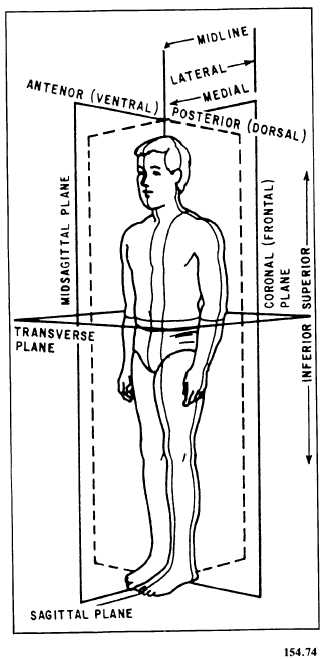CHAPTER 3 ANATOMY AND PHYSIOLOGY
INTRODUCTION
Knowledge of how the human body is constructed and how it works is an important part of the training of everyone concerned with healing the sick or managing emergency conditions following injury. This chapter will provide you with a general knowledge of the structures and functions of the body.
The human body is a combination of organ systems with a supporting framework of muscles and bones and an external covering of skin. The study of the body is divided into the three following sciences:
Anatomy—the study of body structures and the relation of one part to another
Physiology—the study of the processes and functions of the body tissue and organs. Basically, it is the study of how the body works—how the various parts function individually and in relation to each other.
Embryology—the study of the development of the body from a fertilized egg, or ovum.

Figure 3-1.—Planes of the body.
TERMS OF POSITION AND DIRECTION
The planes of the body are imaginary lines dividing it into sections. They are used as reference points in locating anatomical structures. As shown in figure 3-1, the MEDIAN, or MIDSAGITTAL, PLANE divides the body into right and left halves on its vertical axis. This plane passes through the sagittal suture of the cranium; therefore, any plane parallel to it is called a SAGITTAL PLANE. FRONTAL PLANES are drawn perpendicular to the sagittal lines and divide the body into anterior and posterior sections. Since this line passes through the coronal suture of the cranium, frontal planes are also called CORONAL PLANES. The HORIZONTAL, or TRANSVERSE, PLANE, which is drawn at right angles to both sagittal and frontal planes, divides the body into superior and inferior sections. To avoid misunderstanding in describing the location of anatomical structures, a standard body
